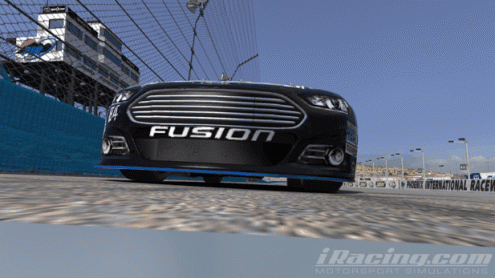
A Team of One – Phoenix International Raceway
February 24th, 2014 by Jaime Baker
Week 2 of the NASCAR iRacing Series brings us to Phoenix International Raceway. Phoenix is a very diverse track with two non-symmetrical corners. It is also rather bumpy compared to its real world counterpart. This means there are several unique challenges that Phoenix brings to the table when we want to build a set-up.
The first thing I want to talk about is what it means to have an old surface. The two biggest obstacles that we have to adapt to are a lack of grip and bumps that upset the behavior of the chassis. What we need to do is get the splitter up and over the bumps. This will eliminate unpredictable variables that can change the behavior of the car. We also need to maximize grip on exit. Specifically on exit. Did I mention that we need grip on exit?
If there is one thing that Phoenix’s two unsymmetrical ends of the track share it is that grip on exit is key. The way that I look at it is you can adjust from a bad entrance to a corner, but you can’t correct from a bad center roll. Optimally, we need rotation without a lack of grip. That won’t happen on this surface.
Before we go into set-up building I want to address some of our mailbag questions. The first comes from Tim Blum:
Q: When you know you want to change make a geometry change, such as the ARB or putting the right rear mount from bottom to top, what can you do to the car to prepare it from being twisted crazy by the new change? Or do you make the change, let the ride heights and preloads freak out and adjust from there?
A: The biggest way to control twisting force on a chassis is ARB pre-load. This can fix almost any problem that you will encounter when you make an adjustment to your car. If there is a big enough differential to where it is impossible to get all heights or pre-loads passing, then you can fine tune using spring perch offset.
Next question comes from Bob Moore:
Q: One question it very important to seal the front splitter but keep it off the asphalt. How do I check that? Review the replay from the front view? Is that accurate best way? While driving inside the cockpit I don’t think I can tell if [it’s] bottoming out or striking the asphalt. Right now it a process of running and reviewing the lap times.
A: I’m glad you asked! I was going to review this anyway but thanks for inquiring. So my answer is yes! You have the right idea! I know that the majority of users on iRacing do not use telemetry to graph the splitter height. So for those of you that want an easy solution, change your camera view. Switch to the rear chassis view when reviewing a lap. Then hit Ctrl + f12. Look towards the top of the settings that appear on the right hand side and adjust the x, y and z axis to check your height. Check out the image below.
Before you make any changes to the fixed or baseline you are using, run laps in the set to pick up speed on the track and find the correct line. Making changes to your set-up before you have the correct line and balance can completely mess you up as you race the rest of the week out.
After I got the feel of the track, I learned that a rolling center and hard exit is where the speed is. Guys can drive 5 cars in too deep and make it stick but I guarantee you that you will get them back 15 laps later. The Gen 6 stock cars are very punishing on the short run. An undisclosed name can go say they are running 26.5s on the forums but I will go and destroy him as soon as we get a 20 lap run.
That being said, we need to get the car balanced for a long run. Balance also includes getting tire wear correct. It is very possible to have a good handling car and still be half a second off pace because you are over cambered.
OK. Let’s begin by talking about what we need to do to get the car balanced before we talk about long run speed. The best way to tackle an unsymmetrical track like this is to find a common similarity and attack the set-up from that point. For Phoenix, we identified the hard exit and center roll we need. The biggest way to begin balancing a car is to adjust to the correct cross-weight. I found that around 55.0% is a good starting point for me. Just tweak ARB pre-load a tad and see if you can get it there. I also added MIN Arm asymmetry just because my left front was not as sealed as I would have preferred. Arm asymmetry seals the left front and creates a little downforce. If you are unfamiliar with the ARB or ARB arms take a look at this photo.
Before you go on track to test an adjustment, set the truck arm pre-load to a positive number. Preferably close to 0.0. You don’t want any twisting force on the chassis when you want to roll the center. I don’t want to ramble on about physics too much so just know that twisting force is not good at a short track.
The second part in finding long run speed is making sure you have rubber under you. #shinnysideuprubbersidedown I don’t mean being the guy that backs up 15 cars on entry or parking it in the center and proceeding to blame me, even if I’m not in your race (it’s happened.) I mean you need to adjust camber so that you have an even spread of heat on the left, center and right edge of the tire. The weight is going to transfer heavily to the front under high braking conditions. At a track like Phoenix, I would add a little right front spring to help the center roll. As you roll the center, make sure it does not start to snap and over rotate. This scrubs speed and like I said before; you can’t recover from a bad center roll. Don’t exaggerate the condition and keep the car under you. As for exit speed, I found the 900 LB RR spring to be a good starting point. If necessary, take a little air out of the RR but stay away from major spring adjustments. To finalize the speed, run a full fuel tank out. Set the car up for the extreme long run. If you are tight at the end of a run but it is still loose at the start I would make it wrecking loose to start. A tenth at the beginning of a run will be five at the end of one.
Some final thoughts I have are to make sure you control the throttle. This is a powerful car and you will destroy the set-up if you do not show throttle control. When you make adjustments, save them. If you find speed save it as a test set-up in you folder. If you find more speed overwrite it. If an adjustment hurts the car revert back and discard changes. Be sure to send me a PM with your questions and I will do my best to out yours in the article. Good luck!



















































